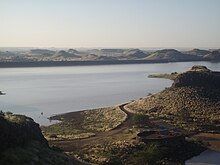
At 824,292 km2 (318,261 sq mi), Namibia is the world's thirty-fourth largest country. After Mongolia, Namibia is the second least densely populated country in the world. Namibia got its name from the Namib desert that stretches along the coast of the Atlantic. It is also known for its wildlife.

The Fish River is a river in Namibia. It is 650 km long, flowing from the Naukluft Mountains 150 km to the Hardap Dam near Mariental. From there the flow is entirely blocked, all further flow downstream coming from tributaries downstream from the dam. The flow of the river is seasonal; in winter the river can dry up completely. Despite this, the river is the site of the spectacular Fish River Canyon, a canyon 160 km long, and at points as much as 550 m deep.

The Vaal Dam in South Africa was constructed in 1938 and lies 77 km south of OR Tambo International Airport, Johannesburg. The lake behind the dam wall has a surface area of about 320 square kilometres (120 sq mi) and is 47 meters deep. The Vaal Dam lies on the Vaal River, which is one of South Africa's strongest-flowing rivers. Other rivers flowing into the dam are the Wilge River, Klip River, Molspruit and Grootspruit. It has over 800 kilometres (500 mi) of shoreline and is South Africa's second biggest dam by area and the fourth largest by volume.

Lake Oroville is a reservoir formed by the Oroville Dam impounding the Feather River, located in Butte County, northern California. The lake is situated 5 miles (8 km) northeast of the city of Oroville, within the Lake Oroville State Recreation Area, in the western foothills of the Sierra Nevada. Known as the second-largest reservoir in California, Lake Oroville is treated as a keystone facility within the California State Water Project by storing water, providing flood control, recreation, freshwater releases to assist in controlling the salinity intrusion into the Sacramento-San Joaquin Delta and protecting fish and wildlife.

Lake Berryessa is the largest lake in Napa County, California. This reservoir in the Vaca Mountains was formed following the construction of the Monticello Dam on Putah Creek in the 1950s. Since the early 1960s, this reservoir has provided water and hydroelectricity to the North Bay region of the San Francisco Bay Area.

Mariental is a town of 10,000 inhabitants in south-central Namibia, lying on the B1 national road 232 kilometres (144 mi) north of Keetmanshoop and 274 kilometres (170 mi) southeast of Windhoek. It lies at an elevation of 1,090 metres (3,580 ft). Mariental is connected to the TransNamib railway line from Windhoek to Keetmanshoop. The town and the surrounding area are situated in a hot, arid region.

Trinity Lake, previously called Clair Engle Lake, is an reservoir on the Trinity River formed by the Trinity Dam and located in Trinity County, California, United States. The dam was built by the U.S. Bureau of Reclamation. The lake's capacity is 2,447,650 acre⋅ft (3,019.13 GL), making it one of the largest reservoirs in California. The lake's surface is at 2,370 ft (720 m) above MSL. Trinity Lake captures and stores water for the Central Valley Project, which provides the Central Valley with water for irrigation and produces hydroelectric power. This lake is known for its many small arms, glassy inlets, and good water-skiing conditions.

The Swakop River is a major river in western central Namibia. Its source is in the Khomas Highland. From there it flows westwards through the town of Okahandja, the historic mission station at Gross Barmen, and the settlement of Otjimbingwe. It then crosses the Namib desert and reaches the Atlantic Ocean at Swakopmund. The Swakop is an ephemeral river; its run-off is roughly 40 million cubic metres per annum.

Pel's fishing owl is a large species of owl in the family Strigidae, found in Africa. It lives near rivers and lakes, and feeds nocturnally on fish and frogs snatched from the surface of lakes and rivers. The species prefers slow-moving rivers with large, overhanging trees to roost in and forage from. It nests in hollows and the forks of large trees. Though as many as two eggs are laid, often only one chick is raised.
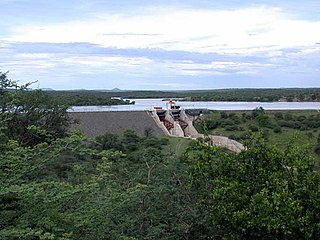
The Von Bach Dam is a rock-fill embankment dam on the Swakop River near Okahandja in the Otjozondjupa Region of Namibia. Built in 1968 and commissioned in 1970, the dam provides Namibia's capital of Windhoek with much of the city's water. It also supplies Okahandja. The dam has a capacity of 48.56 million cubic metres (63,510,000 cu yd). Water from the reservoir is sent directly to a water treatment plant downstream. The treatment plant was completed in 1971 and upgraded in 1997.

Swakoppoort Dam is a dam 50 kilometres (31 mi) outside of Okahandja, Otjozondjupa Region, Namibia. It dams the Swakop River and occasionally receives inflow from the Omatako Dam on Swakop's tributary Omatako. Its capacity is 63.489 million cubic metres (83,040,000 cu yd). Completed in 1978, it is one of three dams to supply water to the capital Windhoek. It also supplies the Navachab mine and the town of Karibib.

A freshwater marsh is a non-tidal, non-forested marsh wetland that contains fresh water, and is continuously or frequently flooded. Freshwater marshes primarily consist of sedges, grasses, and emergent plants. Freshwater marshes are usually found near the mouths of rivers, along lakes, and are present in areas with low drainage like abandoned oxbow lakes. It is the counterpart to the salt marsh, an upper coastal intertidal zone of bio-habitat, which is regularly flushed with sea water.

Camanche Reservoir is an artificial lake in the San Joaquin Valley in California in the United States, at the juncture of Amador, Calaveras, and San Joaquin counties. Its waters are impounded by Camanche Dam, which was completed in 1963. Camanche Reservoir is a source of water for industrial and municipal purposes and also provides flood control.
Klerkskraal Dam is a combined gravity and arch type dam located on the Mooi River, near Ventersdorp, North West, South Africa. It was established in 1969 and its main purpose is to serve for irrigation. The hazard potential of the dam has been ranked high (3). The dam is also a well known bass fishing destination in the region.

The Notwane River is a river in southeastern Botswana. Certain sections of its course form the international boundary with South Africa. Its mouth is at the head of the Limpopo River. It has a catchment area of 18,053 square kilometers.

Kirwin Reservoir is a reservoir in Phillips County, Kansas, United States. It is located next to the city of Kirwin in northern Kansas. The U.S. Bureau of Reclamation built it and continues to operate it for the purposes of flood control and area irrigation. The Kirwin National Wildlife Refuge lies on its shores.
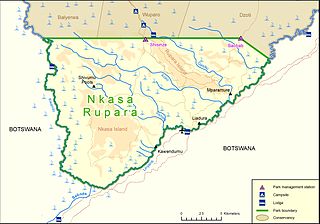
Nkasa Rupara National Park, also Nkasa Lupala National Park, formerly Mamili National Park, is a national park in Namibia. It is centered on the Nkasa and Rupara islands on the Kwando/Linyanti River in the south-western corner of East Caprivi. Botswana lies to the west, south and east, and Sangwali village to the north. It is Namibia's largest formally protected wetland area. It is one of Namibia’s protected areas that benefits local communities surrounding parks. The unfenced park forms a trans-boundary link for wildlife migration between Angola, Botswana, Namibia and Zambia. Nkasa Rupara is part of the Kavango Zambezi Transfrontier Conservation Area.
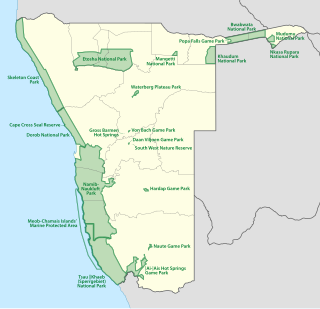
The protected areas of Namibia include its national parks and reserves. With the 2010 declaration of Dorob National Park, Namibia became the first and only country to have its entire coastline protected through a national parks network. Protected areas are subdivided into game reserves and/or nature reserves, such as special protected area, wilderness areas, natural areas, and development areas. There are also recreation reserves. Facilities in the national parks are operated by Namibia Wildlife Resorts. Over 19% of Namibia is protected, an area of some 130,000 square kilometres. However, the Ministry of Environment & Tourism auctions limited hunting rights within its protected areas. The Namibia Nature Foundation, an NGO, was established in 1987 to raise and administer funds for the conservation of wildlife and protected area management. Communal Wildlife Conservancies in Namibia help promote sustainable natural resource management by giving local communities rights to wildlife management and tourism.
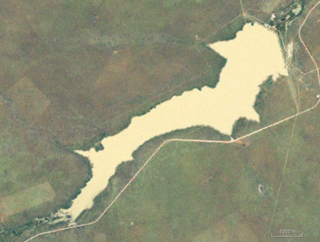
Omatako Dam is an earth-fill embankment dam about 100 kilometres (62 mi) north of Okahandja in the Otjozondjupa Region of Namibia. It is named after the Omatako Mountains, and it dams the ephemeral Omatako River, with Omatako meaning "butt" in Oshiwambo, the name referring to the shape of the Omatako Mountains. The dam has a capacity of 43.49 million cubic metres (56,880,000 cu yd).
The Hardap Recreation Resort is a National Park located in southern Namibia. It was proclaimed in 1968 and measures 252 square kilometres (97 sq mi). Hardap is situated in Hardap Region, about 250 kilometres (160 mi) south of Windhoek and about 24 kilometres (15 mi) west of Mariental. It surrounds the Hardap Dam, Namibia's largest dam, which lies on the Fish River. There is a game park on the southern side of the dam.
